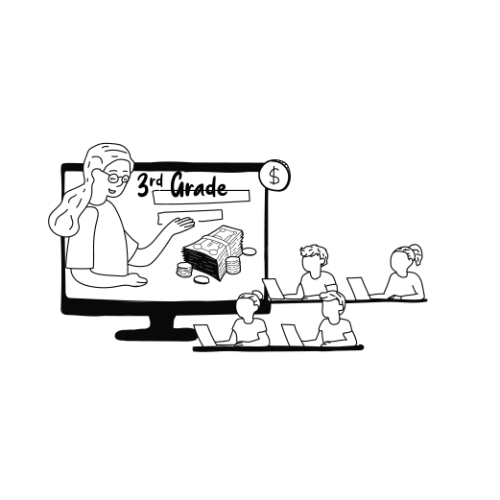Third grade is a critical year in money education. Students begin to see the prevalence of money in life, learn how transactions work, and understand the fundamentals of how economic systems operate. Teachers can build essential background knowledge for their learners, giving kids a rich and solid base to build on in the future. Knowing what precisely to go over with your 3rd-graders can be challenging, though, and it helps if you can turn to a source that lays it out for you. Fortunately, that’s the purpose of this guide. Read on to find out what topics to cover, how to approach the instruction that impacts students, and lesson plans to get your points across. According to the Federal Reserve Bank of Kansas City, this grade has many concepts to focus on, including banking, accounts, deposits and withdrawals, interest, incentives, consumers and producers, employment and specialization, and division of labor. Let’s jump right in and discover the optimal money education for your 3rd-graders!
National Standards for Personal Finance Education
Download Our Free Teachers' Cheat Sheet
Our free cheat sheet covers every learning objective in the National Standards for Personal Finance Education and the corresponding Kids' Money Lesson Plans - we cover each and every standard!
Banking
Your little learners likely have been into the bank. They understand how they work by watching their parents or relatives. You can go into much more depth about the many services they provide to people, such as cashing checks, making loans, and paying interest on various accounts. Teachers can demonstrate the banking process, and how people can put money in or take cash out and use banks for many purposes.
Teaching about banks is essential to this grade level, and you can deliver instruction in many formats. There are many online resources available, and you can use them to set up real-life scenarios for your kids, including:
- Teachers designate one child or pair as the “bank” of the class, rotating regularly. You can go over the various services banks provide and have other students perform transactions at the bank. They can use play money to deposit, withdraw, and maintain accounts with the bank to see how these processes work.
3rd Grade Lesson Plan #1
Banking
Want to Get All 3rd Grade Lesson Plans?
Accounts
As your students develop the concept of storing money in specific places, you can branch out into the topic of accounts. Explain that adults have accounts for various purposes, including savings, checking, retirement, and investments, found in banks or online. You may describe how accounts have balances that go up or down depending on how you manage your money.
You can have students work with accounts in several ways. 3rd-graders love hands-on activities, and there are many, including things like:
- Give each child a set amount of money. They can choose to put all of it in one account, separate it into separate holdings, or keep it loose and not use any account. Show them how they can use accounts to keep money secure, save for large purchases, and how writing checks takes away from their account value, just like spending cash.
3rd Grade Lesson Plan #2
Accounts
Deposits and Withdrawals
As you move through teaching banks and accounts, a natural extension of this instruction is deposits and withdrawals. Teachers can explain that deposits are money put into accounts, and withdrawals are cash taken out of bank holdings. You can show students how people make withdrawals and deposits, explaining that these actions are common and that these transactions affect their account balances.
Kids can have fun learning about deposits and withdrawals. You can have them complete many activities, such as:
- Work with websites that mimic banking transactions like deposits and withdrawals. Your 3rd-grade students can go to a virtual bank, take money out and put it in, to get an idea of the effects of deposits and withdrawals. If you prefer, you can use play money in the classroom to do the same activity, providing students a realistic scenario to learn how these transactions work.
3rd Grade Lesson Plan #3
Deposits and Withdrawals
Interest
Kids are never too young to learn the details of how money works, including the idea of interest. You could define interest for your students as payments made for the use of money and explain how interest is part of many financial situations. Your students can see how interest can be positive (as in savings accounts) or negative (like with loans and mortgages).
It is good to show your students that interest will impact their finances. You can create many learning scenarios demonstrating how interest means higher payments over time. For example, teachers could:
- Display a selection of toys in the classroom with price tags on each. Let students choose one each. You can assign an interest rate to each toy and calculate the total costs for the kids, explaining to them that you will pay more than the sticker price for many products.
3rd Grade Lesson Plan #4
Interest
Incentives
Teachers can move on to the topic of incentives as they continue through 3rd-grade money education. You can explain that incentives are something that influences the behavior of people. You will find many companies using incentives to persuade customers to buy their products, including retail stores and automobile companies. These include cashback, sales, discounted products, and attractive warranties, encouraging consumers to spend at these businesses.
There are many ways to get into the idea of incentives for your students. Incentives tie into the topic of advertising, and you can connect some tactics that companies use to influence customer decisions. Some activities to show this to kids include:
- Have students make a poster advertising their favorite candy. Tell them to include some form of incentive so that people want to buy their product. You can explain that companies use these persuasive techniques all the time to convince people that their goods and services are better than the competition.
Consumers and Producers
As 3rd-graders continue their money education, they will get into consumers and producers. While the terminology can be a little complex, your 3rd-graders will understand that consumers buy “stuff” and producers make it. You can tell them that consumers are people who purchase or use goods and services to satisfy wants, while producers are people who use resources to create goods and services for consumers.
There are many routes to take in teaching this topic, with activities galore. You can have kids:
- Create a Venn diagram showing how consumers and producers are alike and different. Companies target consumers - people who buy their products - through various forms of advertising and strategic pricing. They can list their favorite products, and you can explain that these are examples of production.
3rd Grade Lesson Plan #6
Consumers and Producers
Employment and Specialization
The topic of employment and specialization is essential to teach to your 3rd-graders. Employment is the act of working for a paycheck in various occupations, and you can show them there are many careers and jobs to choose from, each with unique perks, salaries, and qualities of life. Specialization is when people produce only some of the goods they need, and then trade with others to get what they need. This action gives people more time to spend on activities they enjoy or pursue training and education. Teachers can describe how cultures have specialized throughout history and how societies continue to do so today.
You can combine the ideas of employment and specialization in various ways with different activities. You can also focus on one topic at a time, using resources to:
- Have students research careers. They are at a great age to begin wondering what they will be when they grow up and to see if it is realistic or not. For example, many 3rd-graders want to be professional athletes, but they can begin to find alternative careers that are more achievable. You can have students share the findings of their chosen profession, developing presentation and research skills.
3rd Grade Lesson Plan #7
Employment and Specialization
Division of Labor
As you teach the division of labor, you can start by telling your students that it is when workers perform part of a production task. Economies use division of labor to become more efficient, cut costs, and speed up production to increase profits. You can highlight some companies, explaining how they use division of labor to increase the production of goods and enhance and improve services.
The concept of division of labor is crucial to students’ understanding of economic basics, especially in discussions about production. You can find or develop many activities to reinforce this concept, such as
- Tell students to make an assembly line. Explain that this approach has been used to complete products more efficiently for many years. Have them line up in a row, give each student a task, and piece together objects as a team, coming up with finished goods at the end of the line. You can show them videos of the original assembly lines used to make cars and other mass-produced items, demonstrating that division of labor is an effective way to get the task done.

